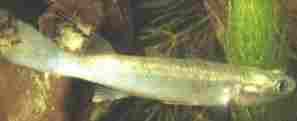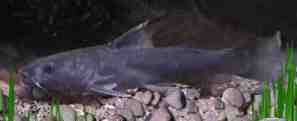Hunting and Feeding in the Smooth-Coated Otter
The information below comes from
Haque & Vijayan, 1995,
Helvoort, Melisch et al, 1996,
Hussain & Choudhury (1998),
IUCN Red List 2000,
Kruuk, Kanchanasaka et al (1994),
Sungei Buloh Nature Reserve
and
A Close Encounter with the Otters of Sungei Buloh.
Prey

 Smooth Otters are principally (>90%) fish eaters, preferring fish larger than 15cm long. Hussain and Choudhury (1998) found that the majority of their food came from just two species of fish - the Riverine Catfish, Rita rita, which is a slow-moving crevice-dweller, and the False Four-Eyed Fish, Rhinomugil corsula, a kind of mullet found in fresh and brackish water, in shoals of up to 200 fish. This two species seems to be favourites of the otters as they take them preferentially, not just because they are abundant. Otters will, however, also take any other abundant and easily caught fish.
Smooth Otters are principally (>90%) fish eaters, preferring fish larger than 15cm long. Hussain and Choudhury (1998) found that the majority of their food came from just two species of fish - the Riverine Catfish, Rita rita, which is a slow-moving crevice-dweller, and the False Four-Eyed Fish, Rhinomugil corsula, a kind of mullet found in fresh and brackish water, in shoals of up to 200 fish. This two species seems to be favourites of the otters as they take them preferentially, not just because they are abundant. Otters will, however, also take any other abundant and easily caught fish.
Like all otters, Smooth Otters will eat almost anything that is plentiful and easy to catch. In the Monsoon (July-August), they will take the fledglings of commensal birds such as the Blue Rock Pigeon, Columbia livia, the Common Shelduck, Tadorna tadorna and the Spot-Billed Duck, Anas poicilorhyna. If frogs are plentiful, then they will eat huge quantities of them.
Turtles, water rats and small snakes are also known to be taken by this species. Crabs are popular in some places at some times of year, especially along the coasts.
Molluscs and insects such as fly larvae, spiders and beetles are found in spraint. These may be eaten directly, or be the stomach contents of eaten fish, as might the vegetation also found in 90% of spraints in Winter and Monsoon. Other otters are known to eat fruit, but whether Smooth Otters do so is not reported.
It is likely that Smooth Otters need to eat at least a third of their bodyweight every day, as like all otters they have a high metabolism. This could be up to 7lb of fish.
Hunting Schedule
Observers in Sungei Buloh National Park, Singapore, have found that the otters hunt by day and by night, with hunting sessions lasting about an hour, and followed by rest periods on the banks.
Hunting Methods
This otter fishes like the Eurasian Otter, Lutra lutra, hunting alone and using whiskers to detect movements in the water. They are, however, more versatile Than many other species - they also use their paws to feel for crabs in mud, and for catfish in crevices. The most striking observations of this animal hunting have been of groups of otters cooperating together, spread in a vague line across a body of water, then moving against the current "undulating wildly" to frighten the fish toward some obstacle such as a waterfall, rapids, mudflats or reeds. The otters then dive and catch the panicked fish in their mouths, moving to land to eat them by tossing them up using their mouths and eating them in one piece head-first. It appears to be true teamwork and cooperation. Families have even been known to join together to make larger hunting parties, splitting up after the hunt and returning to their own home areas.| Smooth-Coated Otter |

